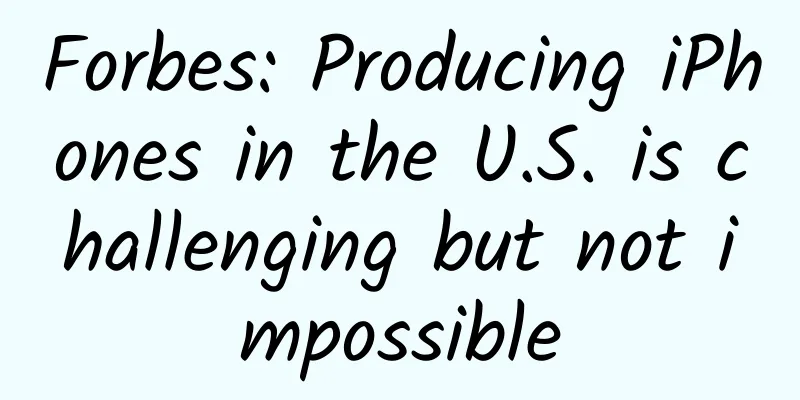Forbes: Producing iPhones in the U.S. is challenging but not impossible

|
According to a report by Forbes Online on October 30, Beijing time, the iPhone is one of the most popular products imported from China by the United States. Just like what Apple wrote on the packaging: "Designed by Apple in California, assembled in China." Although Trump has repeatedly called on Apple to move its production line to the United States, I have always been skeptical about this. However, as trade relations continue to become tense, I have rethought this question - how difficult is it to produce iPhones in the United States? We first need to understand what makes China so suitable for assembling iPhones. There are two important factors: Extremely efficient parts supply chain Looking at the list of iPhone component suppliers, you'll find that most of the key components are made in Asia.
Research firm IHS Markit estimates that the components of the iPhone X cost less than $400, while teardown site iFixit estimates that the components of the iPhone XS Max cost about $390. China has the most efficient electronics supply chain in the world, which refers not only to component suppliers, but also to efficient logistics providers, fast and large customs and import and export facilities, etc. Finished products can leave the factory and be loaded onto cargo ships and cargo planes within a day, or at most two days. Low-cost assembly army Smartphone assembly is complex, similar to assembling a watch. While installing chips on circuit boards relies on automation, many small parts must be assembled by hand, and final assembly is often done by hand as well. These tasks are extremely difficult to automate because Apple designers pack so many parts into these sleek, compact products. If it takes four hours of direct labor to assemble a phone in China, it might add $10 to $20 in costs for Apple, but if it were done in the United States, that figure would be at least $75. The most important feature of China's labor force is that there are many available people and they are extremely flexible. In the second half of 2017, when Foxconn was struggling with the early production of the iPhone X, they sent buses to the factory gates of other nearby companies to recruit workers and attracted them by offering on-the-spot pay raises. According to a recruitment notice, Foxconn offered an hourly wage equivalent to $3.32. Although it was far below the US wage level, Foxconn still recruited enough people and eventually caught up with the deadline. In short, in China, it is not a problem for a company to recruit 50,000 to 100,000 workers in a week, while in the United States, it often takes several months to recruit just 2,500 workers. Can Apple's suppliers move to the United States? Samsung has already moved a large number of its smartphone assembly lines to Vietnam. So, how can Apple suppliers move to the United States? Just as China did in the early 2000s, the U.S. needs to work to get numerous suppliers to set up shop in the U.S. and have them produce close to the final assembly point. We need not only the major component suppliers mentioned above, but also the hundreds of components like multi-layer ceramic chip capacitors that go into every mobile phone. Before assembly, touchscreen displays and metal casings are more fragile, so they must be packed into special shipping boxes. Shipping unassembled parts costs much more than shipping assembled phones. But if the cost of assemblers is lower than shipping the parts, then it would still be cheaper to assemble the phone in China, even if all the parts are made in the United States. But tariffs completely change the equation. Local production doesn't happen overnight, though—it took China more than a decade to do it. Perhaps what the United States really wants to achieve localized production is touch screens, semiconductor chips and batteries. In addition, the United States may also want to localize the production of metal casings, because this work is highly automated. But the challenges are also very significant: it costs about $6.5 billion to build a new generation of display factory, and most of the factories recently built in the United States have not received much government subsidies. Although Foxconn received more than $3 billion in subsidies for its panel factory in Wisconsin, it was not enough because one of its key suppliers did not receive subsidies, which limited the size of the display screens Foxconn could produce. Someone might build a battery factory in the U.S., but it will have to compete with the massive Chinese manufacturers. Ultimately, the supply chain is about cost and efficiency, including manufacturing costs, shipping costs, and tariffs. Will American consumers pay more for American-made products? Coping with peak demand The biggest issue with making iPhones in the US is the ability to assemble a workforce large and flexible enough to meet Apple’s demands. Until phones can be more automated, Apple suppliers will still need a large pool of people willing to do the work. That’s a real challenge in the US today, when employers already have a hard time finding those kinds of workers. That workforce also needs to be flexible enough to expand quickly when a product launches, then shrink when there’s an inevitable trough in demand. Amazon, FedEx, and UPS have all done this, but they hired warehouse workers. We haven’t seen this kind of large-scale seasonal hiring in the manufacturing sector in the US. A more viable location for Apple suppliers is in Mexico. The ultimate plan may be to build basic production capacity in Mexico near the United States and then import from China during peak periods. |
<<: Microsoft shows off its weird Silent Voice technology
Recommend
Douyin Operation: After watching 10,000 Douyin videos, I found that these 8 types of Douyin videos will definitely be popular!
Some people say that short videos are a current b...
Operations are not based on intuition, but are driven by data.
Many college students who are about to graduate w...
How to create a hit product on Xiaohongshu?
If you want to increase the traffic of your Xiaoh...
50% of the creative copywriting for information flow ads is incomprehensible!
About 50% of the creative copywriting in informat...
Cook: Apple Watch must be as irreplaceable as iPhone
[[127747]] Apple CEO Tim Cook attended the Goldma...
“Sewage” fish farming, low-carbon design, harmonious coexistence————the art of pumped storage engineering in the mountains
"The 40 or so young fish we released three y...
Jing Wei: "Short Video Camera Lighting Practical Teaching"
Jing Wei's "Short Video Camera Lighting ...
What types of ads should you pay attention to when promoting Baidu Union?
Baidu Union Promotion is one of the core products...
Is the nuclear radiation from CT scan, a magical tool for cancer detection, very harmful? Nuclide: I am innocent...
The "nuclear" thing has long been widel...
Is the cotton bollworm also picky about food? The cotton bollworm: I don’t like to eat every leaf
Produced by: Science Popularization China Author:...
Ling'er Investment Research Diary "Lightning Rod Escape Top Method" is one step ahead, building positions and escaping tops with indicators
Ling'er Investment Research Diary "Lightn...
An interview question: How did Uber recruit 1,000 drivers in a week?
An interview question and answer for an Uber oper...
How to plan high-conversion activities in live broadcast rooms?
Today, let’s discuss how to conduct private domai...
Car companies increase investment in local markets, forecast says China's luxury car market is expected to become the world's largest this year
In the past two years, the series of "rebell...









